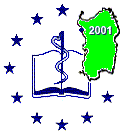 |
Paper library / hybrid
library: an obstacle course?
Elisabetta Marinoni, Pierangela Mazzon,
Monica Ortolan, Donata Pieri, Antonella Zane, Roberta Sato*
|
|
|
|
|
|
 |
Some of the Padova Academy's scientific libraries made their first approaches toward a digital library in 1999 when the editors of many paper journals owned by these libraries allow on-line versions available free-of-charge. Since those years, the amount of journals available on-line increased dramatically. NewJour, a new journal and newsletter announcement list for new serials on the Internet including the ones free or in press, listed 5905 titles at the date of June 10, 1998. On June 14, 1999 it archived 7898 titles, then after less than a year; on March 7, 2000 it showed 8474 titles. More recently, on May 8, 2001, 10423 titles of electronic publications were present showing an increase of 80% in just three years (Fig. 1).
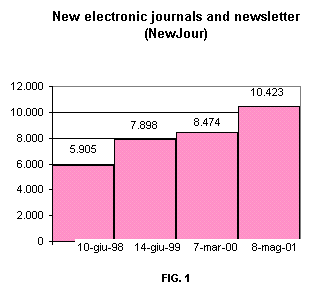 A project to make subscriptions to periodicals in electronic format from the most important European publishing houses available to students, researchers and faculty was begun in 1999 at the University of Padova. This project was accomplished in the year 2000, with the acquisition of the electronic journal databases: Science Direct (Elsevier) and Synergy (Blackwell). The simultaneous shrinking of funds made available by libraries and the vertiginous rise of the dollar, combined with a general increase in subscription costs, resulted in the decision to eliminate many paper subscriptions for which on-line versions were available. Most of these subscriptions were for periodicals of strategic interest for users and the transition from paper versions to on-line versions was a very critical period. The objective of the current work is to examine the implications for access to information and for training that these new scenarios have had in two libraries, each of which is of a different size and each of which has different objectives. The Vallisneri Biomedical Library, fills a teaching/scientific role, offering its services to a vast range of users (students, researchers, faculty, staff), while the "E. Meneghetti" Department of Pharmacology and Anaesthesiology Library has a primarily research role. An analysis is made of the organisational and management problems caused by the transition from a paper library to a hybrid library. In particular we focus our attention on the integration of e-journals and on solutions found in order to render the transition as smooth as possible for the users of our libraries. The first problem we had to face up was the lack of a general database of reference, collecting all the data of e-journals subscribed by the University of Padua and its libraries. At the moment, the only centralised service is Silverlinker which allows users to access Elsevier and Blackwell e- catalogues (1400 e-journals full-text), from Silverplatter bibliographic databases available on the Erl platform. As e-journals represent an important information resource for Vallisneri and Meneghetti libraries with a significant increasing number of journal titles year by year, as shown in Figs. 2 and 3, the need of an autonomous tool to integrate e-journals among the collections traditionally managed by a paper library, became urgent. Considering the wide spectrum of typology of our customers (students, researchers, faculty, staff), we considered as fundamental organising access and information to these Web resources on different levels.
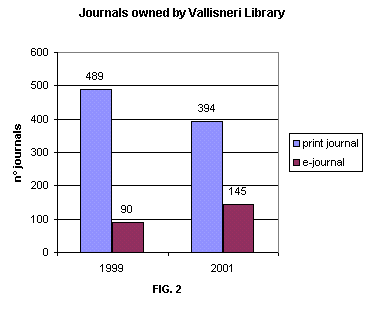 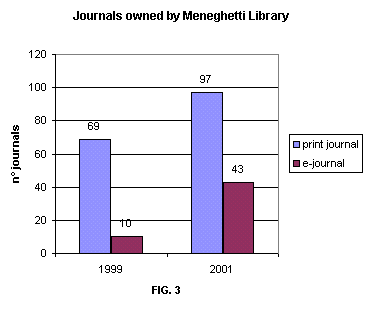 The "A. Vallisneri" Biomedical Library Vallisneri library has recently developed a portal, enabling users to access a large quantity of resources. This service was organised in order to offer multiple access to e-journal and allow different search strategies. From the "search serials" Web page, users connect both to print journal catalogue and e-journal catalogue with the search query set for a journal title search. The first catalogue adds, to the bibliographic data, the link to the publisher Web site whereas e-journal catalogue's record lists all the Uniform Resource Locators (URLs) available for that resource (publisher Web site and aggregator services), typology of the online document (Table of Contents, Abstracts, Full Text), username and password, notes. Due to licences and terms conditions provided by each publisher, we had to place a domain restriction to e-journal catalogue access. In fact this catalogue includes only e-journals owned by the library (current and ceased) and available with no extra-cost: a) journals whose electronic edition mainly comes with library print subscription; b) digital collections of Science Direct and Synergy, purchased by Padova Academy (Fig.4).
 From our "search serials" Web page, a link leads also to a full list of biomedical e-journals gathered from disciplinary gateways. For used-to browse-users, e-journals (in subscription and free ) are also available from our "links by subject" Web page where we have organised a framework of links to Web resources along the lines of the LC classification system. To amplify information on electronic
resources, special advertisement and labels on the shelves inform inexpert
users how to access to full text of their journal.
The "E. Meneghetti" Department of Pharmacology and Anaesthesiology Library Is composed of two small research libraries (Pharmacology and Anaesthesiology which merged to form just one library in the year 2000. They are located in two physically distinguished buildings, inside the University Area. They have a small bunch of scientific journals which are accessible in both version: electronic and paper. The library does not own a Web page (which is by now building-up). In order to enable Department faculty, researchers and library users to access to e-journals, the librarians have made available some journal lists containing: the title and URL of the electronic journals subscribed by the Department; the title and URL of the Elsevier and Blackwell journals (subscribed directly from the University of Padova) and of other journals subscribed locally from other libraries of the University; the link to e-journals, related to medical disciplines, available free in the net (Fig. 5). These journal lists have been stored on a public directory of the local net servers. They are periodically updated and any change or new implementation is communicated by e-mail directly to the Department-staff (professor and researchers).
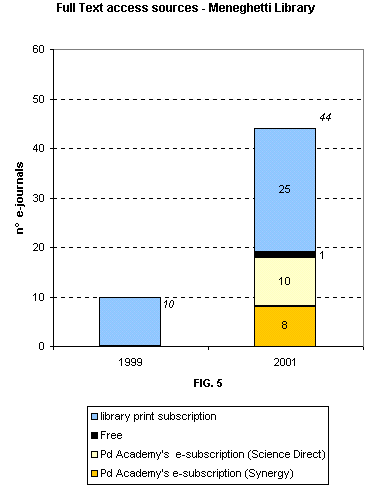 The complex world of e-journals, with its multiple access systems and formats, requires a qualified reference assistance and information searching skills. Both our libraries offer training courses for students on the use of electronic journals and generally on Web resources. These courses are integrated within faculty syllabuses and involve hundreds of students every year. Our future plans are directed towards
setting up a usability test and interviews with library customers, monitoring
user feedback especially that of undergraduate students. The goals should
be to carry out a more precise personalisation of help tools tailored on
the different typology of our users .
References 1. Adams Michael. Digital Libraries
Planning, Managing, and Adapting to Change. Serials Review 1999; 25: 70-72.
|
|
|
|
|